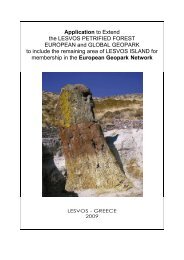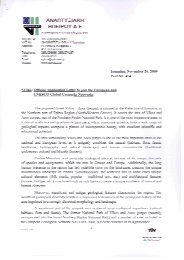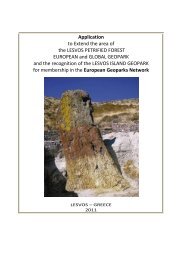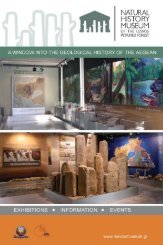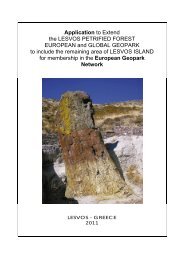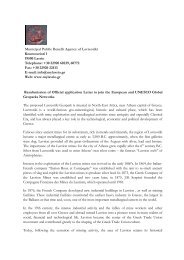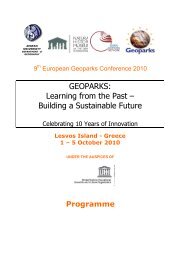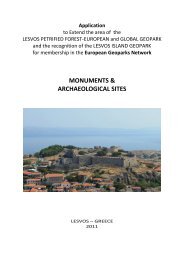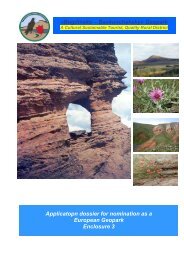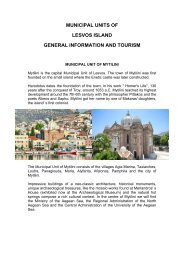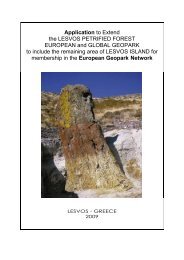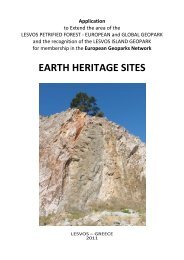9th European Geoparks Conference – Lesvos, 1-5 October 2010
9th European Geoparks Conference – Lesvos, 1-5 October 2010
9th European Geoparks Conference – Lesvos, 1-5 October 2010
Create successful ePaper yourself
Turn your PDF publications into a flip-book with our unique Google optimized e-Paper software.
9 th <strong>European</strong> <strong>Geoparks</strong> <strong>Conference</strong> <strong>–</strong> <strong>Lesvos</strong>, 1-5 <strong>October</strong> <strong>2010</strong><br />
Focused on “Learning from the Past <strong>–</strong> Building a Sustainable Future”, the 9 th <strong>European</strong><br />
<strong>Geoparks</strong> <strong>Conference</strong> held in <strong>Lesvos</strong>, at the premises of the University of the Aegean in<br />
Mytilene, highlighted topics related to the promotion and protection of natural monuments and<br />
the development of quality tourism. The <strong>Conference</strong> was attended by 350 delegates from 41<br />
countries, among which were representatives of UNESCO, the <strong>European</strong> and Global <strong>Geoparks</strong><br />
Networks, the International Union of Geological Sciences, the International Geographical Union<br />
and the International Union for Conservation of Nature, academics and members of scientific<br />
institutes, as well as representatives of the state and local authorities of Greece and many<br />
other countries.<br />
The <strong>Conference</strong> was the largest in the<br />
history of <strong>Geoparks</strong>, during which 10<br />
keynote talks were given, 138 papers were<br />
presented orally and 12 on posters.<br />
Attendance exceeded all previous in terms<br />
of country representation and of<br />
presentation quality. In particular, the<br />
speakers came from several <strong>European</strong><br />
countries, i.e. Austria, Croatia, Czech<br />
Republic, Finland, France, Germany,<br />
Greece, Holland, Hungary, Ireland, Italy,<br />
Kosovo, Norway, Poland, Romania,<br />
Portugal, Russia, Slovakia, Slovenia,<br />
Sweden and United Kingdom, but also from<br />
Australia, Brazil, Chile, China, Ethiopia,<br />
India, Indonesia, Iran, Korea, Malaysia,<br />
Saudi Arabia, Uruguay, and Vietnam.<br />
The <strong>9th</strong> <strong>European</strong> <strong>Geoparks</strong> <strong>Conference</strong><br />
was organized under the auspices of<br />
UNESCO, after a decision by the Director-<br />
General Irina Bokova. The conference was<br />
co-organized by the <strong>Lesvos</strong> Petrified Forest<br />
and the Geography Department of the<br />
University of the Aegean, and was<br />
supported by the Greek Ministry of Culture<br />
and Tourism and the General Secretariat for the Aegean and Island Policy. In particular, the<br />
issues that the 24 <strong>Conference</strong> sessions dealt with were: the development of <strong>Geoparks</strong> in<br />
Europe and globally, the role of geoparks in the protection of geological heritage, the impact<br />
of climate change and the role of geoparks in its understanding, the development of<br />
geotourism, the economic benefits and local development, the promotion of geological<br />
heritage and communication to the public, presentation and promotion of <strong>Geoparks</strong> as a<br />
quality tourist destination, the future of <strong>Geoparks</strong>. In the five thematic symposia proposals<br />
were sought on the economic dimension of <strong>Geoparks</strong>, on the management of geological<br />
heritage and the services offered to visitors during their visit to a Geopark.
First day of the <strong>Conference</strong> in the Municipal Theatre of Mytilene<br />
After their registration and the warm welcome by Assoc. Prof. N. Zouros, President of the<br />
<strong>Conference</strong>’s Organising Committee and Director of the NHMLPF, and Prof. A. Kelepertzis,<br />
President of the Directorial Board of the NHMLPF, on the first day of the <strong>Conference</strong>, 1 st<br />
<strong>October</strong>, the participants could follow three sessions with 5 key-note talks by Dr. P. McKeever<br />
(UNESCO <strong>Geoparks</strong> Bureau Member & EGN Vice-Coordinator), Dr. M. Patzak (representative of<br />
UNESCO), Prof. D. Mountrakis (Professor of geology in the Geology Dept., Aristotle University<br />
of Thessaloniki, Greece), Dr. G. Martini and Dr. M.L. Frey (UNESCO <strong>Geoparks</strong> Bureau<br />
Members) and C. Eckhardt (Bergstrasse-Odenwald Geopark, Germany) and nine 20-minute<br />
oral talks, in the Municipal Theatre of Mytilene. The oral presentations in the three opening<br />
sessions had themes related with: <strong>Geoparks</strong>-Global strategy for Geoconservation and<br />
Sustainable Development, <strong>Geoparks</strong>-Aspect Diversity, Principles on Geopark Development and<br />
they were given by a very international group of speakers, coming literally from the four<br />
corners of the world (China, France, Greece, Ireland, Italy, Japan, Spain, United Kingdom).<br />
Opening Ceremony<br />
The official opening ceremony of the Congress was held in the Municipal Theatre of Mytilene in<br />
the evening of the 1 st <strong>October</strong>. The ceremony was attended by the Greek Deputy Minister of<br />
Environment, Energy and Climate Change, N. Sifounakis, the Deputy Mayor of Mytilene Mr. P.<br />
Paterellis, the Vice Rector of the University of the Aegean and Professor in the Geography<br />
Dept. Dr. N. Soulakellis, the representative of UNESCO’s Division of Ecological and Earth<br />
Sciences Dr. Margarete Patzak, the Vice President of the International Union of Geological<br />
Sciences Prof. Jacques Charvet, the Head of the World Heritage Programme at the<br />
International Union for Conservation of Nature Tim Badman.<br />
The Deputy Minister of Environment, Energy and Climate Change, N. Sifounakis, opening the<br />
conference, referred to the need for enhancement of natural and geological monuments and
the efforts of the Greek state for the promotion of the <strong>Lesvos</strong> Petrified Forest. He also referred<br />
to the contribution of UNESCO’s Global <strong>Geoparks</strong> Network and the <strong>European</strong> <strong>Geoparks</strong><br />
Network for the promotion and protection of our natural heritage, since “…geoparks study the<br />
past and face the future...” , as he stated. The next speaker, representative of UNESCO, Dr.<br />
Margarete Patzak, stressed the importance of <strong>Geoparks</strong> to the protection of natural heritage<br />
and the development of local communities. For UNESCO, the operation of the <strong>European</strong><br />
<strong>Geoparks</strong> Network is an example for developing similar networks in other continents.<br />
Following, the Vice President of the International Union of Geological Sciences, Prof. Jacques<br />
Charvet, stressed that geoparks are an excellent opportunity for cooperation between the<br />
scientific community and local communities for the enhancement of natural resources and<br />
utilization of the potential of local communities. The last speaker, Dr. Patrick McKeever, Vice<br />
Coordinator of the <strong>European</strong> <strong>Geoparks</strong> Network, referred to the role of the <strong>European</strong> <strong>Geoparks</strong><br />
Network for the promotion of protected natural monuments and its contribution to the<br />
development of quality tourism throughout Europe, and stressed that <strong>Lesvos</strong> is a perfect<br />
example of successful development for all <strong>Geoparks</strong>, both in Europe and worldwide.<br />
Wishes for the success of the Congress were sent by the General Secretary of the Ministry of<br />
Culture, Ms. L. Mendoni, the General Secretary of the North Aegean Region, Ms. S.<br />
Theologitou, and the Rector of the University of Aegean, Prof. of Tourism at the Business<br />
Administration Dept., Dr. P. Tsartas.<br />
During the opening ceremony, a special<br />
celebratory event was held, as this year<br />
marks 10 years since the establishment of<br />
the <strong>European</strong> <strong>Geoparks</strong> Network, and<br />
special certificates were awarded to the 42<br />
members of the Network by the Deputy<br />
Minister Mr. N. Sifounakis.<br />
The evening closed with the <strong>Conference</strong>’s<br />
official dinner, in a local taverna, where the<br />
guests could taste the delicious local<br />
delicacies.<br />
Two days of presentations, forums and symposia in the University of the Aegean<br />
The two days that followed, the 2 nd and 3 rd <strong>October</strong>, were very eventful. On the second<br />
<strong>Conference</strong> day, three parallel oral presentation sessions were held, in three different<br />
amphitheatres of the Geography Dept. of the University of the Aegean.<br />
In Room 1, two keynote presentations were given, by Dr. Ibrahim Komoo (UNESCO <strong>Geoparks</strong><br />
Bureau Member and Asia Pacific <strong>Geoparks</strong> Network Coordinator) and Denise Gorfinkiel<br />
(UNESCO Program Officer for Earth Sciences in the Latin American and Caribbean).<br />
Subsequently, 18 interesting talks were given, separated in 3 sessions, all presenting Aspiring<br />
<strong>Geoparks</strong> all around the world (Brazil, Canada, Chile, France, Greece, India, Ireland, Italy,<br />
Japan, Korea, Netherlands, Portugal, Slovakia, Vietnam).<br />
In Room A, a keynote presentation was given by Kristin Rangnes (Gea Norvegica Geopark).<br />
Afterwards, 14 20-mintute talks were presented, separated into 3 sessions, related with<br />
<strong>Geoparks</strong> and International collaboration, <strong>Geoparks</strong>-Interpretation and Communication,<br />
<strong>Geoparks</strong> and Climate adaptation. The speakers presented examples of collaboration among<br />
geoparks, which are usually based on common features between the two parts and target to a
common goal; also examples of good practise of communicating geoheritage and geodiversity<br />
in various geoparks were given. Finally, three interesting talks presented how the “hot” issue<br />
of our century, climate change, can be presented to public aiming to raising awareness.<br />
In Room C, a keynote presentation by Assis. Prof. I. Spilanis and L. Vayanni (Dept. of<br />
Environmental Studies, University of the Aegean) was followed by 16 20-minute talks on Best<br />
practices in geoconservation and sustainable development, <strong>Geoparks</strong> and nature tourism<br />
development, <strong>Geoparks</strong>, local participation and sustainable development.<br />
In parallel to the <strong>Conference</strong>’s three different session groups, in the frames of the <strong>Conference</strong>,<br />
an Educational Forum was taking place in the Marine Sciences Amphitheatre of the University<br />
of the Aegean. During the whole day, 18 talks were given, separated into three sessions on<br />
Environmental education, Educational programs on abiotic nature and <strong>Geoparks</strong> and<br />
environmental education.<br />
In the halls of the Geography Dept., during the whole day, 12 posters were presented, with a<br />
variety of themes, all related with <strong>Geoparks</strong>, local development and tools of earth sciences<br />
interpretation.<br />
In the evening of this busy day, after the presentations in the university, the participants were<br />
invited to the Medieval Castle of Mytilene, the largest of its kind in the eastern Mediterranean<br />
area. There, they were welcomed by Dr. C. Loupou, Chief Archaeologist of the 14 th Ephorate<br />
of Byzantine Antiquities, and they were guided through the impressive monument. The<br />
surprise of the evening and best way to close a very tiring day was a concert, inside the castle,<br />
by the “Santouria of Agiassos”, presenting Greek traditional music from the area of the east<br />
Aegean and the coasts of Asia Minor.<br />
The following day was equally eventful and busy. In Room 1 of the Geography Dept., a<br />
keynote speech was given by Dr. M.L. Frey (Director of the World Heritage Site Messel Pit,<br />
Germany) on the role of World Heritage Sites in <strong>Geoparks</strong> for the sustainable development.<br />
Afterwards, 20 talks were given, during which remarkable and unique aspiring geoparks were<br />
presented to the participants.<br />
In parallel, in Room A, 15 talks were presented, on Research in <strong>Geoparks</strong>, proving that a great<br />
part of current geological, geographical, geo-conservational knowledge is produced within<br />
areas of geoparks, by their scientific staff.<br />
In Room B of the Geography Dept., 11 talks were presented, all of them related with Best<br />
practives in management, geotourism and education within <strong>Geoparks</strong>. Finally, in the Marine<br />
sciences Amphitheatre, 12 oral presentations were given, focused on Geoconservation policy<br />
and practices and Evaluating Earth heritage.<br />
In the afternoon of the same day, six different Symposia were organised, each one dedicated<br />
to one Thematic Network. After small introductions by the organizers of the Thematic<br />
Networks, member contributions and discussion followed on: Coastal <strong>Geoparks</strong>, <strong>Geoparks</strong> and<br />
Fossils, Glacial-Periglacial <strong>Geoparks</strong>, Mining <strong>Geoparks</strong>, Tectonic-Alpine <strong>Geoparks</strong> and Volcanic<br />
<strong>Geoparks</strong>. Very interesting ideas and suggestions were arisen, strengthening the collaboration<br />
among the members of the <strong>Geoparks</strong> Networks.<br />
Impressed by the Lesbian natural and cultural heritage<br />
During their stay, the participants had the opportunity to participate in two field trips around<br />
the island, during which they visited protected areas and parks of the <strong>Lesvos</strong> Petrified Forest,<br />
as well as other impressive geotopes of <strong>Lesvos</strong> (e.g. the volcano of Lepetymnos, the Vatoussa<br />
caldera, the volcanic centres of Eressos and Mesotopos, the columnar lavas of Ordymnos, the
volcanic neck of Petra, the Agia Paraskevi fault) and important nature reserves of the island<br />
(e.g. the Gulf of Kalloni, important wetland where 68 bird species can be found).<br />
They were also guided to many cultural monuments of the island, such as the archaeological<br />
site of Mesa, where they discussed the use of geological research in the identification of<br />
monument structural materials, the Museum of Industrial Olive-Oil Production in Agia<br />
Paraskevi, the church of the Archangel in Mantamados, the castle of Molivos, the church of<br />
Virgin Mary in Petra and Byzantine monasteries of the island.<br />
The delegates were welcomed to the NHMLPF in Sigri by the President of the Local Sigri<br />
Council and member of the Directory Board of the NHMLPF, Mr. A. Athanasiadis. During their<br />
visit to the Museum, the delegates were informed about the Museum’s activities regarding<br />
fossil research and conservation, environmental education and natural heritage promotion, and<br />
they had the chance to experience the results of the Museum’s contribution to geotourism<br />
development in the area.<br />
The participants, many of whom are specialists in themes regarding conservation and<br />
promotion of natural resources, noted the very high level of the existing infrastructure, but<br />
also the exemplary promotion tools of the <strong>Lesvos</strong> Petrified Forest; they acknowledged that<br />
great potential for the development of quality tourism in <strong>Lesvos</strong> is offered through the multilevel<br />
action of the NHMLPF. They indicated that the uniqueness of the monument worldwide<br />
can offer much more to the development of the island, however for this purpose the<br />
promotion within the scientific community is not enough, but the communication and<br />
interpretation of the <strong>Lesvos</strong> Petrified Forest to the wider public is required, since the<br />
impressive geo-monument possesses all the potential required for be establishment not only of<br />
<strong>Lesvos</strong> but also of Greece as a major tourist attraction. They further acknowledged the<br />
progress made in recent years, with the completion of the permanent exhibitions of the<br />
Museum, and highlighted the uniqueness of the Museum among similar museums worldwide.<br />
They were impressed by the quality information service available free of charge to all visitors,<br />
through the use of the new Museum’s eGuide. Finally, they were overwhelmed during their<br />
experience on one of the most important educational tools of the Museum, the earthquake<br />
simulator designed as a school classroom, which acquaints visitors of the <strong>Lesvos</strong> Petrified<br />
Forest to the seismic risk, which is particularly high in Greece and the wider Mediterranean<br />
region.<br />
At the closure of the conference,<br />
participants warmly congratulated for the<br />
excellent organization, and also for the<br />
infrastructure available in the Museum and<br />
the University of the Aegean for the<br />
realization of such high-level conferences.<br />
The beauty of the lesbian landscape, the<br />
quality of local products, the delicious<br />
dishes prepared by the women's<br />
agrotourist cooperatives of Parakoila,<br />
Mesotopos, Skalochori and Petra and the<br />
lesbian hospitality have undoubtedly<br />
contributed decisively to the success of the<br />
organization.



